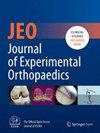Severity-dependent recovery time in acute lateral ankle sprains: An ultrasonographic assessment of talofibular displacement
Abstract
Purpose
There is no consensus on treatment protocols based on severity and timing for acute lateral ankle sprain (LAS). Appropriate decision-making is necessary to prevent reinjury or chronic ankle instability. In this retrospective observational study, we clarified the duration of recovery from anterior ankle joint displacement in patients with initial acute LAS of several severities.
Methods
Overall, 101 patients with varying grades of initial unilateral LAS were included. Injury severity was based on ligament tears and anterior ankle joint displacement using the reverse anterior drawer test with ultrasonography. The automated length measurement system software measured changes in the talofibular distance.
Results
The median (95% confidence interval) change in the talofibular distance on the affected side was 1.24 (0.96–1.76), 3.03 (2.91–3.74) and 3.06 (2.37–4.69) mm for LAS grades I, II and III, respectively, on the first medical examination. The increase in talofibular distance for grade I injuries was significantly smaller than for Grades II and III (p < 0.01). The regression equation was y = –0.02 × days + 1.43, –0.05 × days + 3.30 and –0.05 × days + 3.42 for Grades I, II and III, respectively; the time it took to reach the value of the unaffected side was 14.5, 43.2 and 45.6 days, respectively. Regression coefficients were significantly greater for Grades II and III than for Grade I (p < 0.01 and p = 0.01, respectively). No significant differences were observed between Grades II and III.
Conclusion
These results revealed that the recovery time for displacement varies according to the severity of the sprain, suggesting the need to develop optimal treatment protocols.
Level of Evidence
Level III.

 求助内容:
求助内容: 应助结果提醒方式:
应助结果提醒方式:


